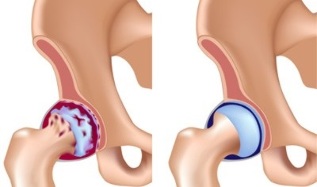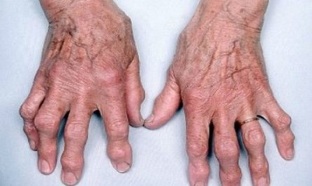These two words are quite similar in hearing comprehension, so many who say the words "arthritis" and "arthrosis" have no idea that they are completely different diseases, although they have joint problems. In fact, both diseases are very serious and it is worth knowing the difference between arthritis and arthrosis, if only to avoid getting embarrassed in a conversation because the topic of health is one of the “eternal” topics when one personcommunicates with the other.
What is arthritis
Arthritis is a disease that affects most middle-aged people (under 40), although there are exceptions. According to statistics, few people suffer from arthritis, up to 2% of the total population. In essence, however, arthritis is a severe inflammatory process in which joint problems are only a visible part of widespread inflammation.
In arthritis, the main cause of the disease is much deeper than swelling of the joints, as well as pain that does not leave the patient during the night's rest (sometimes these pains only get worse). This inflammation can be caused by an infection or a defect in the immune system. The joints are not the only organs affected by inflammation. Often a huge blow falls on a person’s internal organs such as the liver, heart and kidneys. If the problem of arthritis is ignored, it is very dangerous not only for human health but even for life.
What is arthrosis

Arthrosis is generally the age-related change a person goes through, most often closer to the middle of the second half of life. Quite often, the mechanism of arthrosis is triggered by severe injuries in the form of fractures and joint damage in people over 45 years of age.
According to medical statistics, one in three people over the age of 50 and one in two people over the age of seventy suffer from arthrosis. About 10% of the inhabitants of our planet suffer from arthrosis. Most often, arthrosis affects the knees and hip joints of the elderly. In addition, the joints of the fingers and ankles may be exposed to osteoarthritis.
Causes of diseases
Obviously, the causes of each disease are completely different.
In case of arthritis, these could be:
- Injuries of various origins, to a greater extent, recurrent recurrent injuries related to professional activity can provoke the disease;
- Infections such as tuberculosis, fungal infection, SARS, influenza;
- Vitamin deficiency and consequent imbalance;
- Body overload;
- Nervous system disorders;
- Disorders of your own immune system;
- Genetically inherited predisposition to arthritis.
Arthritis is a common accompaniment to professions such as seamstress, hairdresser, masseur, loader, construction worker.
As far as arthrosis is concerned, the factors behind the development of the disease are as follows:
- Overweight, which affects the function of joints;
- Poor nutrition;
- Prolonged hypothermia;
- He had suffered various injuries in the past (perhaps a long time ago);
- Poisoning the body;
- Metabolic disorders;
- Previous infectious diseases;
- Manifestations of autoimmune disorders;
- Perthes disease, manifested by altered blood supply to the femoral head;
- Disorders of the thyroid gland;
Hereditary predisposition to arthrosis spreads at the genetic level.
Severe symptoms of arthritis
Arthritis causes severe pain in the joints, especially during walking or other physical activity. The joint itself swells noticeably and the skin around the joint becomes hot to the touch. In addition, the skin may turn red. The patient develops a feeling of weakness, it is very difficult for him to perform any movement with the affected arm or leg. It is especially difficult after a night’s rest in the morning. When the joint is pressed, the patient feels severe pain. When performing movements, joints affected by arthritis can cause severe cracking. The patient may have a high body temperature and the patient himself may suffer from chills. In acute arthritis, all symptoms appear simultaneously and suddenly. In chronic arthritis, the symptoms increase slowly and gradually.
Symptoms of arthrosis

In the case of arthrosis, doctors distinguish four main symptoms of the disease:
- Joint pain.The pain is severe and sharp. It begins the moment the movement begins and subsides with the transition to the rest state. At night, the person has virtually no pain, and once he has chosen a comfortable position, the patient can sleep peacefully. The feeling of pain increases as the disease progresses. The pain is worse in both cold and rainy weather;
- Cracking of joints.Due to the reduced freedom and softness of bone rotation, a strong crackle can be heard in the joint. Experts distinguish arthritis with a kind of "dry" sound. The further the disease progresses, the stronger the cracking in the joints. One of the characteristics of the cracking of arthritis is that the cracking is almost always accompanied by pain;
- Limiting the mobility of the joint itself.In many cases of arthrosis, the limb is immobile. This is due to the fact that an increase in bone formation occurs and the joint space narrows, leading first to a restriction of mobility and then to complete immobilization of the joint;
- Deformation of joints.As a general rule, this symptom is characteristic of the late stages of the development of arthrosis, when osteophytes grow.
Difference between arthritis and arthrosis according to clinical picture
It is quite clear that arthritis and arthrosis are of different origins as diseases. If arthritis is the result of a malfunction of the immune system or an infectious disease, arthrosis is more likely to refer to diseases that result from the aging process of the body. Accordingly, based on this, the clinical picture of the manifestations of arthritis and arthrosis will also be different.
Arthritis of the fingers

So with arthritis of the fingers, the patient has severe pain that does not subside at rest or at rest. In addition, the skin around the affected joints turned red.
Arthritis can affect different numbers of joints, from one (monoarthritis) to several (polyarthritis). The joints were swollen. The reaction of depressing the joint can be sharp pain.
As for the cracking of the joint, there may not be.
Finger osteoarthritis
It is most common in the elderly, and osteoarthritis is about ten times more common in women than in the stronger sex. The main site of localization is the joints between the phalanges of the fingers.
Any movement of the fingers causes uncomfortable pain in the patient. At rest, however, there is virtually no pain. The joints may be swollen and redness may occur around the affected joint. Arthrosis is always accompanied by a "dry" crack in the joints.
The same picture is observed in cases of arthritis and arthrosis of the toes.
Treatment with chondreoprotectors
In arthritis and arthrosis, cartilage is destroyed by contact with the rough and rough surface of the bone. As a result, the process of producing the synovial fluid is interrupted, the cartilage is nourished and the joint is deprived of the lubrication required for its normal functioning.
The chondroprotector prevents these pathological processes. The active ingredients of the chondoprotectors are glucosamine and chondroitin sulfate. Dosage forms for the release of these substances vary and can be used by physicians depending on the situation.
Today, chondroprotectors are produced in the following form:
- Solution for injection;
- Tablets;
- Creams, ointments and gels.

Chondroprotective treatment should be started before complete cartilage collapse. Unfortunately, such a treatment is absolutely useless if the cartilage is destroyed. The next thing to keep in mind during treatment with chondroprotectors is the duration of treatment. In fact, the process of cartilage repair is quite long and the minimum treatment time should be six months, but practice shows that treatment with chondroprotectors takes an average of one and a half to two years. If the recovery is not completed, cartilage destruction will continue. As a general rule, chondroprotectors do not have any side effects on the patient’s body, the maximum mild bowel disorder observed in practice. The only complication may arise in the treatment of chondroprotectors in patients with diabetes mellitus. When treating them, the dose of insulin should be calculated correctly as chondreoprotectors contain glucose. And the use of a chondroprotector as well as for the treatment of children is not recommended during pregnancy.
There are many effective drugs in the arsenal of doctors today to treat the problems of arthritis and arthrosis.
Treatment with chondroprotectors should be started under the supervision of a doctor, otherwise treatment may be ineffective.
Treatment with folk remedies
For arthritis, traditional medicine suggests a number of effective recipes:
- Apple cider vinegar.This substance is added to water (1 teaspoon to a glass of water). The resulting solution is drunk before meals;
- Potato compaction.Take green tubers for the compress.
Washing, cut into pieces, without peeling. The potatoes are heated in water at a temperature of 38 degrees. Compression is then applied to the sore spot. The potato layer should be 1, 5 - 2 centimeters. Must be received at night. Treatment in this way lasts seven to ten days.
Ointments for the treatment of arthritis and arthrosis
External use of ointments in the early stages of arthritis and arthrosis may help treat the patient. The specialist will select the appropriate drug based on the results of the test.

























